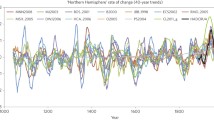Abstract
The extent to which ozone has been decreasing over the past two decades has been reported by many researchers and the results have been summarized in periodic international scientific assessments on ozone depletion (e.g. WMO, 1991; 1994). These assessments have quantified the long-term trends in ozone as functions of latitude and time of year and have summarized findings which associate these changes to enhanced levels of stratospheric chlorine and bromine that are anthropogenic in origin. The long-term trend values are based on the results of analyses of stratospheric ozone measurements which have been made routinely on a global scale for nearly four decades.
Access this chapter
Tax calculation will be finalised at checkout
Purchases are for personal use only
Preview
Unable to display preview. Download preview PDF.
Similar content being viewed by others
References
Burrows, W., M. Vallee, D.I. Wardle, J.B. Kerr, L.J. Wilson and D.W. Tarasick. 1995. “The Canadian UV-B and Total Ozone Forecast Model.” Met. Apps. 1: 247–265.
Burrows, W. 1997. “Cart Regression Models for Predicting UV Radiation at the Ground in the Presence of Cloud and Other Environmental Factors.” J. Appl. Meteorol. 36: 531–544.
Eck, T.F., P.K. Bhartia and J.B. Kerr. 1995. “Satellite Estimation of Spectral UV-B Irradiance Using TOMS-Derived Total Ozone and UV Reflectivity.” Geophys. Res. Lett. 22: 611–614.
Fioletov, V.E. and J.B. Kerr. 1997. “Numerical Relationship Between UV Irradiance, Total Ozone, and Other Variables from Analysis of Brewer Spectral UV-B Measurements Archived at the World Ozone and UV Data Centre.” Proceedings of the Quadrennial Ozone Symposium (forthcoming).
Fioletov, V.E., J.B. Kerr and D.I. Wardle. 1997. “The Relationship Between Total Ozone and Spectral UV Irradiance from Brewer Spectrophotometer Observations and its Use for Derivation of Total Ozone from UV Measurements.” Submitted to GRL.
Frederick, J.E., P.F. Soulen, S.B. Diaz, I. Smolskaia, C.R. Booth, T. Lucas and D. Neuschuler. 1993. “Solar Ultraviolet Irradiance Observed from Southern Argentina: September 1990 to March 1991.” J. Geophys. Res. 98: 8891–8897.
Herman, J.R., P.K. Bhartia, J. Ziemke, Z. Ahmad and D. Larko. 1996. “UV-B Radiation Increases (1979–1992) from Decreases in Total Ozone.” Geophys. Res. Lett 23: 2117–2120.
Kerr, J.B., C.T. McElroy, D.I. Wardle and D.W. Tarasick. 1994. “The Canadian Ozone Watch and UV-B Advisory Programs.” In Ozone in the Troposphere and Stratosphere. Proceedings of the Quadrennial Ozone Symposium 1992, NASA Conference Publication 3266, Berlin: Springer-Verlag, 794–797.
Kerr, J.B. and C.T. McElroy. 1993. “Evidence for Large Upward Trends of Ultraviolet-B Radiation Linked to Ozone Depletion.” Science. 262: 1032–1034.
Kerr, J.B. and C.T. McElroy. 1994. “Analyzing Ultraviolet-B Radiation: Is There a Trend?” Science. 264: 1342–1343.
Kerr, J.B. 1997. “Observed Dependencies of Atmospheric UV Radiation and Trends.” NATO ASI Series. Vol. 152, Eds. C.S. Zerefos and A.F. Bais, Berlin: Springer-Verlag, 259–266.
Madronich S. 1992. “Implications of Recent Total Ozone Measurements for Biologically Active Altraviolet Radiation Reaching the Earth’s Surface.” Geophys. Res. Lett. 19: 37–40.
McKinley, A.F. and B.L. Diffey. 1987. “A Reference Spectrum for Ultraviolet Induced Erythema in Human Skin.” In Human Exposure to Ultraviolet Radiation: Risks and Regulations. Edited by W.R. Passchler and B.F.M. Bosnajokovic, Amsterdam: Elsevier.
WMO. 1991. Scientific Assessment of Stratospheric Ozone: 1991. World Meteorological Organization. Global Ozone Research and Monitoring Project, Report No. 25. Geneva: World Meteorological Organization.
WMO. 1994. Scientific Assessment of Stratospheric Ozone: 1994. World Meteorological Organization. Global Ozone Research and Monitoring Project, Report No. 37. Geneva: World Meteorological Organization.
Editor information
Editors and Affiliations
Rights and permissions
Copyright information
© 1998 Springer Science+Business Media New York
About this chapter
Cite this chapter
Kerr, J.B. (1998). The Evolving Uv Climate. In: Le Prestre, P.G., Reid, J.D., Morehouse, E.T. (eds) Protecting the Ozone Layer. Springer, Boston, MA. https://doi.org/10.1007/978-1-4615-5585-8_4
Download citation
DOI: https://doi.org/10.1007/978-1-4615-5585-8_4
Publisher Name: Springer, Boston, MA
Print ISBN: 978-1-4613-7555-5
Online ISBN: 978-1-4615-5585-8
eBook Packages: Springer Book Archive




